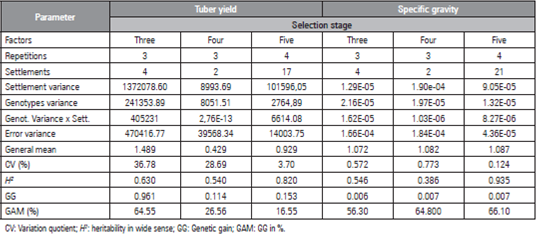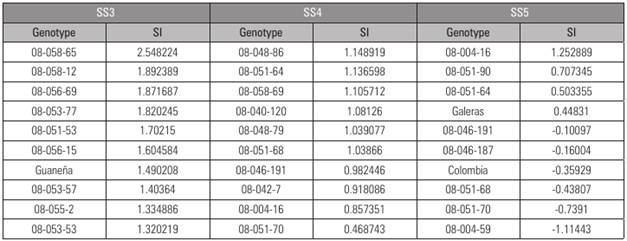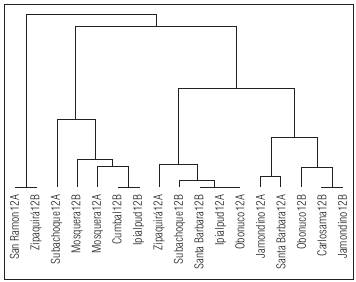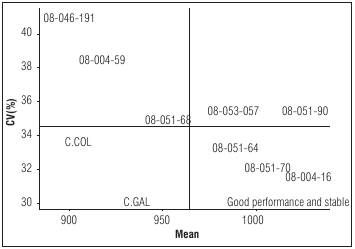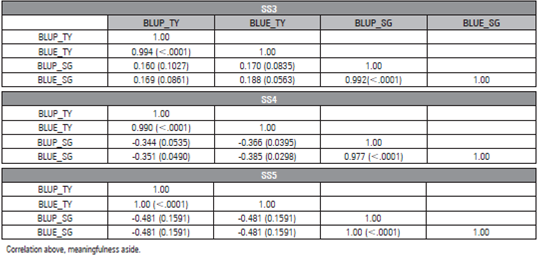INTRODUCTION
The yellow diploid potato (Solanum tuberosum L. grup Phureja) (Huamán and Spooner, 2002) is one of the most important plant genetic resources in Colombia. This potato is known for its nutritional value, color, flavor, texture and rapid cooking (Rivera et al., 2011; Peña et al., 2015; Gómez et al., 2018). It poses good efficiency potential, higher early blooming, an absence of tuber dormancy, resistance to biotic and abiotic factors, specific adaptations to different environments and an unexplored source of genes usable in plant breeding programs (Rodríguez, 2013). Individuals from the Phureja group have been characterized as a good source for iron and zinc (Burgos et al., 2007).
Efficiency and nutritional quality are influenced by environmental effects (Bonierbale et al. 2004, Rodríguez-Pérez, 2010; Hammond et al., 2011; PGSC, 2011; Li et al., 2013) and genetic expression. Likewise, they control the weight and starch content. These variables, when estimated, can increase the accuracy of selection in advanced breeding stages (Rivera et al., 2011; Li et al., 2013). To do so, it is necessary to rigorously discriminate characteristics of high heritability and easy phenotypical characterization, such as shape and color. Multiplication rates and late selection occurs for variables such as efficiency and characteristics with low heritability in late stages of selection (Poehlman and Allen, 2003).
The success of a plant breeding program depends on the capacity to deliver genotypes that guarantee high performance in terms of efficiency and/or quality across a range of environmental conditions. The genotype by environment interaction (GXE) is the result of a differential response of genotypes across environments. GXE analyses and estimations have the potential to generate information on genotype characteristics, identifying superior ones for specific environmental conditions. This potato has wide adaptability and a high efficiency potential, as determined by the GXE. The most desirable cultivar is the one combining high efficiency and stability.
Federer and Raghavarao (1975) pointed out that the analysis of variance is useful for estimating the variance components associated with genotypes, environments and their interaction. This provides information on the stability of genotypes that, calculated across heritability in a broad sense (H2), enables the establishment of new genotypes and possible parental plants in a breeding program. One option for estimating the average value of genotypes or families is a minimum-quadratic estimation (Littell et al., 2006). Under the assumption of normality and independence from errors, it provides the best linear unbiased estimate (BLUE) (Littell et al., 2006; Ticona-Benavente and Silva, 2015).
For the improvement of the potato, an assessment of new genotypes through the establishment of augmented designs that enable the assessment of hundreds of genotypes without the use of replicas is recommended (Federer, 1998; Benavente et al., 2011). Moreover, within the predictive power of BLUE, heritability or information from parental plants are not considered, thereby removing power from the selection analysis (Ticona-Benavente and Silva, 2015). The removal of assumed presuppositions within BLUE led Henderson (1953,1984) and Patterson and Thompson (1971) to structure the basis for the best linear unbiased predictor (BLUP) (Henderson, 2012; Ticona-Benavente and Silva, 2015), used to estimate random effects in a mixed model (Piepho et al., 2008). This allowed predictions of a more accurate genetic value in the search for new varieties and genetic values in parental selection (Piepho et al., 2008; Ticona-Benavente and Silva, 2015).
BLUP values show predictive accuracy when compared to other procedures since the pedigree information is often included via the numerator relation matrix, which is often susceptible to analysis via a simple mixed model. The estimation of genetic values is mainly based on models with fixed effects, eliminating variations and bringing the response value closer to the genotypic response (Piepho et al., 1994; Piepho, 2008). Some studies on selection in advanced stages (close to obtaining a variety) based on BLUP methodologies have been carried out in species such as beans (Ferreira et al., 2008), yams (Borges et al., 2010), oil palm (Flori and Hamon, 2001), sugar cane (Barbosa et al., 2014), sorghum (Filho and Tardin, 2014), corn (Bernardo, 1995,1996; Olivoto et al., 2017), and cassava (Ceballos et al., 2016).
In plant breeding, besides BLUP, the implementation of a Selection Index (SI) enables the selection of individuals for incorporation in a later stage of assessment. This process is carried out based on the phenotypic values observed for several traits of each candidate individual (Cerón-Rojas et al., 2006). As defined by Smith (1936), SI originally assigns subjective economic weight to each trait, with the disadvantage that it requires large amounts of information, making weight assignment difficult. Thus, the Eigen value selection index method (ESIM) appears to be an alternative for the selection of genotypes in advanced stages of a selection program since it takes into account the proportion of traits contributing to the SI, which can involve two or more variables in the construction of the index with differential economic values, prioritized by relevant variables according to the species (Cerón-Rojas et al., 2006, 2016).
Although some work has been done in simulated data for potatoes (Slater et al., 2014; Ticona-Benavente and Silva, 2015), the estimation of BLUP and the application of ESIM are pioneering methods for the analysis of selection programs for the diploid potato. The objective of this study was the implementation of BLUP and ESIM as a strategy for the selection of superior families and genotypes in three advanced selective stages in the yellow diploid potato breeding program at the Universidad National de Colombia.
MATERIALS AND METHODS
Advanced lines of yellow diploid potato genotypes (Solanum tuberosum Group Phureja) were developed with hybridization obtained from crosses of different diploid parents (Tab. 1) cultivated and selected in different years and locations in a process of participative selection research with small farmers.
Table 1 Genealogy of 25 generations of F1 families; parentheses indicate the number of genotypes evaluated by family.
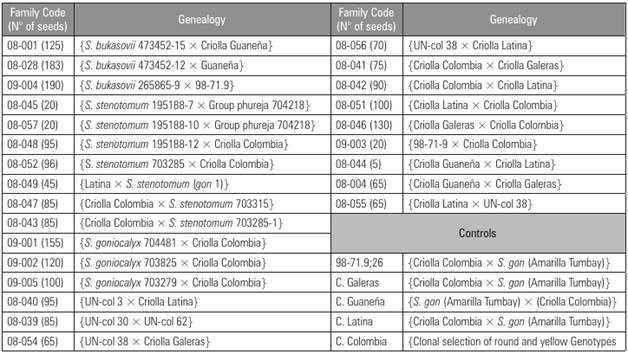
With materials from familiar selection obtained in two stages and after characterization based on variables of shape and color, three additional selection stages were established: three (SS3), four (SS4) and five (SS5), which facilitate advancement in the obtained population. SS3 corresponded to the establishment of four evaluations of diploid potato using 100 advanced genotypes, chosen with participative selection processes with farmers in the municipalities of Facatativa (Cundinamarca), Medellin (Antioquia), Pasto (Nariño) and Chipaque (Cundinamarca). SS4 corresponded to the evaluation of 30 genotypes selected in SS3 in two municipalities, Facatativa (Cundinamarca) and Pasto (Nariño). SS5 corresponded to the evaluation of eight genotypes and two controls that were evaluated in eleven settlements that represent the "papa criolla" productive system in Colombia, (Carlosama, Cumbal, Ipialpud, Jamondino, Mosquera, Obonuco, Tuquerres, in Nariño and San Ramon, Santa Barbara, Subachoque and Zipaquira, in Cundinamarca), located between 2400 and 2800 m, during two consecutive semesters.
For the three stages of selection, a full block design was randomly established, with four repetitions. The experiment unit was made up of 40 m2 plots with a distance of 1.0 m between furrows and 0.3 m between sites. Each plant was fertilized with 30 g of the compound N-P-K (10-20-20). The evaluated variables were tuber yield (TY) and specific gravity (SG), according to Araujo et al. (2020).
Bearing in mind that the data corresponded to three multi-environmental evaluations in order to obtain the mean of each genotype in each settlement. The BLUPs (Henderson, 1984) were calculated assuming the genotypes were random effects and the settlements were fixed effects.
The value for heritability (H2) was obtained in a broad sense for each assay and each settlement. The settlements where heritability was under 0.5 were eliminated since high variance values might imply an elevated error value. The calculations were made using the settlements where heritability was H2= 0.5; meaning a genetic gain (GG) and its percentage (GAM) significant, following Poehlman and Allen’s (2003) procedure.
For the determination of the ESIM specific values of SI were used in each stage, from the matrix of correlation between efficiency and specific gravity (Cerón-Rojas, 2006, 2008). To obtain the individual index for each genotype, the corresponding BLUP values were used, along with the MIXED procedure in SAS, 9.4. In order to prove that the effect of settlement was statistically meaningful, Ward’s method of variance cluster was used with an ANOVA analysis to classify the settlements according to the TY variable. For the classification of genotypes, the quadrant method (Francis and Kanenberg, 1978), based on the mean and CV of the cultivar across the environments was used.
Finally, the correlation values between the BLUP and BLUE of response variables were used as a method for the verification of the impact of using variance components as fixed or random effects in each of the stages of an advanced breeding program.
RESULTS AND DISCUSSION
For the TY variable, based on the BLUP values, the predicted mean for SS3 was 1.489 kg/plant, SS4 was 0.429 kg/plant and SS5 was 0.929 kg/plant (Tab. 2).Non-BLUP average values for SS3, Es4 and Es5 were 1.520, 0.443, and 0.964 kg/plant, respectively.
The changes between the observed values and the predicted BLUP values for TY were rather similar, in accordance with Barbosa et al. (2014). Although the GAM value of the analyzed population decreased, 64.55% (SS3) 26.56% (SS4), and 16.55% (SS5), (Tab. 2), it indicated that it is a logical consequence of superior genotypes in advanced stages. This means that, as a response to the selection of values observed for predicting familiar or genetic values, it is a relative improvement for the heritability value and a constant decrease in variation (as occurred in this study), where the value of heritability for TY in two states shifted from 0.63 to 0.82 and CV decreased from 36.78 a 3.70%, confirming the report by Ticona-Benavente and Pinto (2012) (Tab. 2).
Bearing in mind that the selection states are consecutive, the TY gain is guaranteed, based on the addition of the GG values at the end of stage five, to be 1.228 kg/plant, which is high since the genetic advancement of potatoes consists of the multiplication of material in a vegetative manner that may be related to the environmental effect. This produces a positive consequence in the response variable for some environments, such as a better offer for the genotypes (Cotes et al., 2000; Rivadeneira et al., 2016).
One of the criteria for this type of analysis is values for inheritability under 0.5 (Carlosama 12A, Cumbal 12A, San Ramón 12B, Túquerres 12A, Túquerres 12B) that were not taken into account, which is the reason why only 17 settlements were included for TY. For SS3, the value H2=0.63 for the efficiency characteristic indicated that it is related to an effective selection of superior families during the first few generations, as reported by Ticona-Benavente and Silva (2015).
The high value for H 2 = 0.82 in SS5 corresponds to a value across all settlements. This value may be related to an efficient selection pressure, which led to the proper selection of superior individuals, ensuring high heritability for superior individuals. The values for thee genetic parameters may increase based on the efficiency of the BLUP methodology, keeping in mind that the selection of individuals must have an organoleptic characteristics component (special shape and color). This affects final selection, which is focused on obtaining genotypes with a high commercial potential in the tetraploid potato (Ticona-Benavente and Silva, 2015).
Additionally, efficiency is considerably affected by the environment and might also be influenced by the inclusion of diversity generated in the population by introducing wild parents and bred diploids.
For the variable SG, the mean predicted for SS3 was 1.072, SS4 was 1.082 and SS5 was 1.087, using BLUP values. The average Non-BLUP values without prediction for Es3, Es4 and SS5 were 1.080, 1.081, and 1.088, respectively. It was evident that the adjustment with the BLUP methodology determined that the average predicted value for SG would change, decreasing from 1.083 to 1.080. (Tab. 2). However, individual responses of selection display higher variability, which might imply the incorporation of characteristics such as shape and color (Robinson, 1991; Piepho et al., 2008), generating a better estimation under the BLUP proposal.
In agreement with the variable TY for SG in SS5, the analysis of information was carried out based on 21 settlements since heritability in Carlosama 12A was lower than 0.5. As a result, the values for H 2 for the SG characteristic ranged between 0.38 and 0.93. The superior values matched the ones reported by Ticona-Benavente and Silva (2015).
The GAM values showed no meaningful advancement within the selective states, indicating that, for the SG variable performing familiar selection, a greater advancement was achieved in the early stages of selection by decreasing the selective pressure to values of 50%. This would negate the need for exhaustive selection in later stages, indicating that predicted values might enable an increase in GG so long as pressure decreases to 30% (Ticona-Benavente and Silva, 2015).
Selection index
Using a selection pressure near 10% as the criterion for a population susceptible to improvement based on an analysis of specific values for SS3, SS4 and SS5, the top 10 genotypes were obtained (Tab. 3).
The families that provided the selected individuals were 08-051 (Criolla Latina × Criolla Colombia), 08-046 (Criolla Guaneña × Criolla Colombia), and 08-004 (Criolla Guaneña × Criolla Galeras). Criolla Galeras and Criolla Colombia were highlighted as parents that enabled the selection of individuals that became new cultivars, implying that they had a high, unexplored potential for improvement leading to an increase in efficiency or even the improvement of complex characteristics.
The reduction of superior families occurred mainly because phenotypical resemblance is a tendency that genetically related individuals have towards sharing a greater number of genes with each other than with the general population because of the variation for efficiency potential among and within families in a population of diploid potatoes. They are thus grouped according to the principle that phenotypic resemblance among related individuals increases efficiency or even the improvement of complex characteristics.
The main particularity of genetic improvement in potatoes lies in vegetative multiplication, which guarantees homogeneity in tubers obtained with an identical genetic base. Therefore, when a desirable genotype is identified, it can be multiplied and maintained generation after generation without genetic segregation, offering a great advantage over crops that only multiply through botanic cuttings or sexual seeds.
In order to establish the effect of GXE on advanced genotypes on SS5, it was initially proven that its effect was statistically meaningful via ANOVA analysis. In order to classify the settlements by the variable TY, a grouping method was applied (Fig. 1.), resulting in similarities and creating four major groups: San Ramon 12A and Zipaquira 12B, which corresponded to group 1, an external group; Subachoque 12 A, Mosquera 12 A and 12B, Cumbal 12A and Ipialpud 12B, corresponding to group 2; Zipaquira 12A, Subachoque 12B, Santa Barbara 12B, Ipialpud 12 A and Obonuco 12 A, corresponding to group 3, and Jamondino 12A, Santa Barbara 12B, Obonuco 12B, Carlosama 12B and Jamondino 12B in group 4. This grouping indicated similarities among the settlements and, therefore, their conditions.
Francis and Kanenberg’s (1978) quadrant method identified superior genotypes as those possessing a high mean and low CV for the RT variable (Fig. 2).
Volpato et al. (2019) indicated that BLUP values enable an accurate estimate of the genetic parameters in multi-trait, multi-environment evaluations (MTME) that, under the quadrant method, identified the genotypes 08-051-90, 08-004-16, and 08-053-57 as having a high mean for the TY variable and acceptable CV, along with round, yellow tubers with shallow buds, good flavor and texture. All these conditions are appreciated in the improvement of the yellow diploid potato, making them suitable phenotypes for registry as new cultivars for Colombia.
BLUE vs. BLUP contrast
The TY and SG variables for SS3, SS4 and SS5 showed a high degree of correlation between the BLUP vs. BLUE values and were highly meaningful (α=0.05) for the response variables (Tab. 4).
High correlations for advanced stages of the associated variable responses indicated that there was no higher relevance if the effects are treated as fixed or random. This is why a BLUP methodology is advised since it provides more modest responses, which have a low tolerance effect on extreme genotypic responses, and provides a view of possible behaviors in further testing, as expressed by Vittorazzi et al. (2017) who indicated that the application of BLUP results in a higher estimated gain than those applied from classic biometric selection index methodologies, and BLUP should be incorporated in the progenie section.
CONCLUSION
The implementation of BLUP values and ESIM in advanced selection stages is a tool that can improve the selection methodology because it facilitates the integration of response variables that are corrected and organized within an index, allowing discrimination of the best genotypes.
For selection stage five, an efficient statistical support was achieved. It corroborated the description for obtaining genotypes as registered varieties, indicating that the technique has a high potential for discriminating between genotypes and within them to select superior genotypes.
The GXE analysis facilitated the characterization of the settlements and showed the better ones, making this analysis an additional tool that provides an even more restrictive discrimination, associating a superior behavior with a better environment.
H2 is a genetic parameter that, once obtained from the BLUP values, can be used in advanced selection stages for the variables TY and SG.
Genetic improvement in diploid potatoes is an option for developing genotypes with a high agronomic value, high efficiency potential and superior characteristics in color, texture, flavor and early blooming, taking advantage of heterotic values present in diploid populations and thus revealing a seldom-explored path for global improvement programs.














